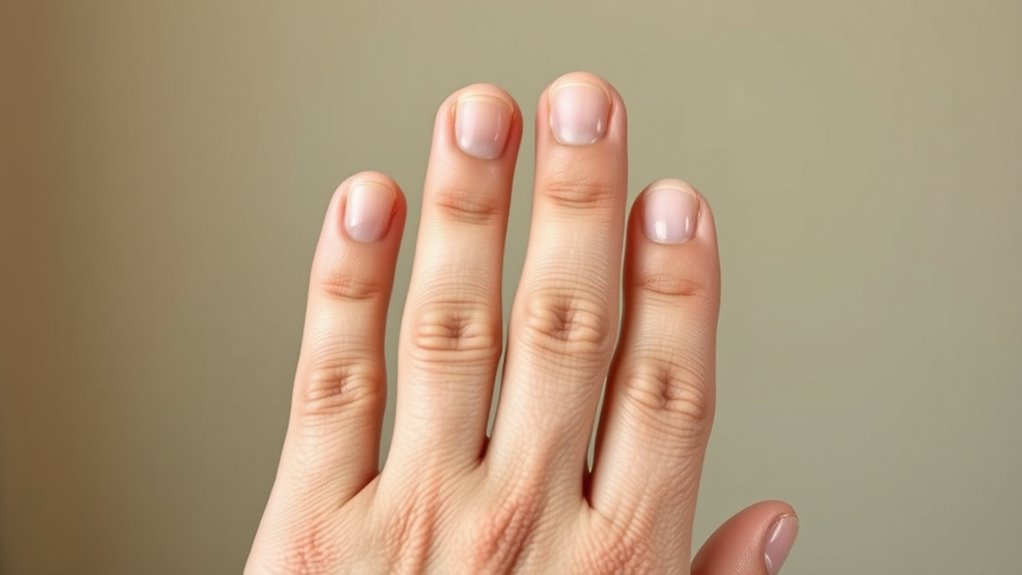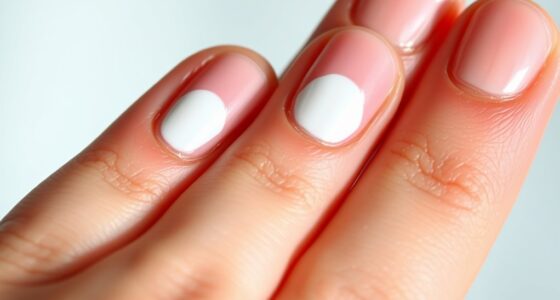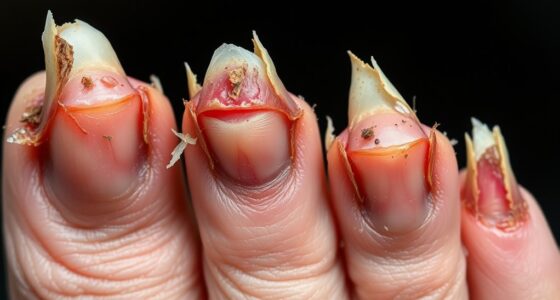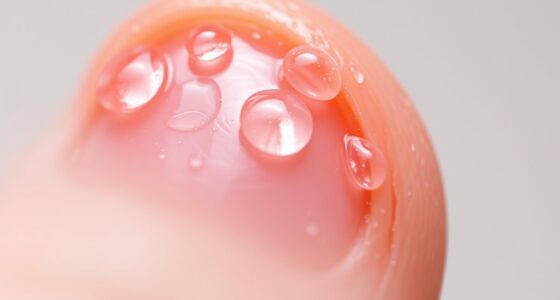As you age, your nails become thinner, more brittle, and prone to cracking due to decreased keratin resilience. Cuticles also dry out and lose elasticity, increasing infection risk. To adapt, focus on nourishing treatments like cuticle oils, biotin, and proper hydration. Avoid harsh chemicals and aggressive cuticle trimming. Regular gentle maintenance helps preserve nail strength and flexibility. If you want practical tips to keep your nails healthy with age, keep exploring for more insights.
Key Takeaways
- Nails become thinner, weaker, and more prone to cracking due to decreased keratin density with age.
- Cuticles tend to dry out and lose elasticity, increasing hangnails and infection risk.
- Aging nails benefit from nourishing oils, biotin, and hydration to maintain strength and flexibility.
- Gentle care practices, like softening cuticles and avoiding harsh chemicals, help prevent damage.
- Maintaining proper nutrition and minimizing polish or acrylic use supports overall nail health as you age.
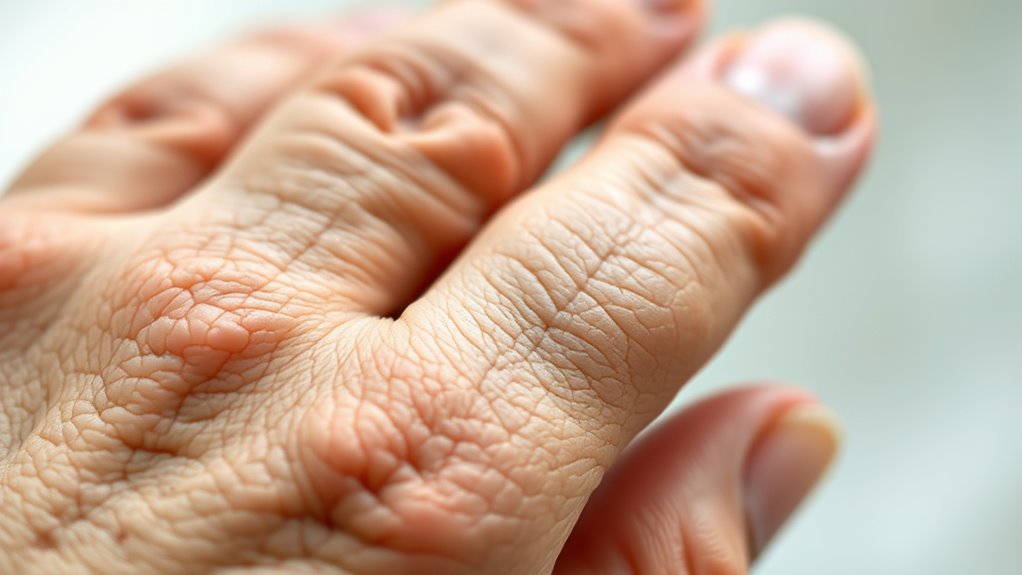
Have you noticed how your nails change as you age? It’s a common experience—your once strong and resilient nails might become thinner, more brittle, or prone to splitting. This isn’t just a cosmetic issue; it reflects the natural shifts happening in your body. As you get older, your nail strength decreases, and your cuticle health can decline, making your nails more vulnerable to damage. Understanding these changes helps you adapt your nail care routine effectively, preserving your nails’ health and appearance.
As we age, nails weaken and become more prone to damage, reflecting natural body changes.
One of the main reasons your nails weaken over time is because the keratin, the protein that forms your nails, becomes less dense and less resilient. This means that everyday activities or minor impacts can cause more damage, such as cracking or splitting. To combat this, you should focus on strengthening your nails by incorporating nourishing treatments, like nail hardeners or cuticle oils, into your routine. These products help reinforce nail structure, making them less prone to breakage. Also, maintaining a balanced diet rich in biotin, vitamin E, and zinc supports nail strength from the inside out. Proper hydration plays a role too—dry, brittle nails are more likely to crack, so drinking plenty of water is essential.
Cuticle health also tends to decline with age. As you get older, your cuticles can become drier and less elastic, which increases the risk of hangnails and infections. To keep your cuticles healthy, avoid cutting them aggressively, as this can cause damage and open the door for bacteria. Instead, gently push back your cuticles after softening them with warm water or cuticle oil. Regularly moisturizing your cuticles helps maintain their flexibility and prevents cracking. Look for products containing nourishing ingredients like vitamin E or jojoba oil. Protecting your hands from harsh chemicals and excessive water exposure also plays a *vital* role in maintaining both nail strength and cuticle health. Additionally, understanding nail structure and composition can help you choose the most effective treatments and care techniques for aging nails.
Finally, don’t forget to give your nails a break from polish and acrylics, which can weaken the nail surface and dry out the cuticles. Use gentle, acetone-free removers and keep your nails buffed and moisturized. With a little extra care, you can adapt to the natural aging process and keep your nails looking healthy and strong. Remember, your nails are a reflection of your overall health, so paying attention to their changing needs is an important part of aging gracefully.
Frequently Asked Questions
Can Aging Cause Permanent Changes to Nail Shape?
Aging can cause permanent nail shape changes, leading to alterations that might not revert. You may notice your nails becoming thicker, brittle, or developing ridges, which can result in permanent nail alterations over time. These changes are often due to decreased cell turnover and blood flow. While some nail shape changes are unavoidable, maintaining good nail care and consulting a dermatologist can help manage these signs of aging effectively.
Do Older Nails Grow Faster or Slower?
Well, your nails definitely don’t get a sudden burst of energy as you age—they actually grow slower, like a sluggish snail on a Sunday stroll. This slowdown affects nail pigmentation and strength, making them more brittle and discolored over time. So, instead of speedy growth, expect your nails to take their sweet time, demanding extra love and care to stay strong and vibrant as you age.
Are There Specific Nutrients for Aging Nails?
You should focus on specific nutrients for aging nails, like biotin, zinc, and iron, which support strength and growth. Incorporate dietary supplements and maintain proper hydration strategies to keep your nails healthy. Eating a balanced diet rich in vitamins and minerals also helps. Remember, staying consistent with these habits can improve nail resilience as you age, preventing brittleness and breakage.
How Can I Prevent Nail Infections as I Age?
You might notice a coincidence—nail infections increase with age. To prevent them, focus on good nail hygiene by keeping your nails dry and clean. Avoid sharing tools, and wear gloves when doing chores. If you spot signs of infection, use antifungal treatments promptly. Regularly moisturizing your cuticles also helps maintain healthy nails. Staying vigilant and practicing these habits can markedly reduce your risk of nail infections.
Do Nail Polish and Treatments Affect Aging Nails Differently?
Nail polish effects and treatment impacts can vary as you age, often making nails more fragile. Some nail polishes contain chemicals that dry out or weaken nails, accelerating aging signs. Harsh treatments or frequent use can cause peeling or breakage. To protect your nails, choose gentle, nourishing polishes and limit harsh treatments. Regularly moisturizing and giving your nails breaks from polish help maintain healthy, youthful-looking nails over time.
Conclusion
As you age, your nails change, but with proper care, you can keep them healthy and strong. Did you know that about 50% of people over 50 experience nail thinning or brittleness? By adjusting your routine—moisturizing regularly and avoiding harsh chemicals—you can combat these changes and maintain beautiful nails. Embrace these simple tips, and you’ll enjoy healthier nails at any age. Your hands deserve the best care, so stay proactive!
